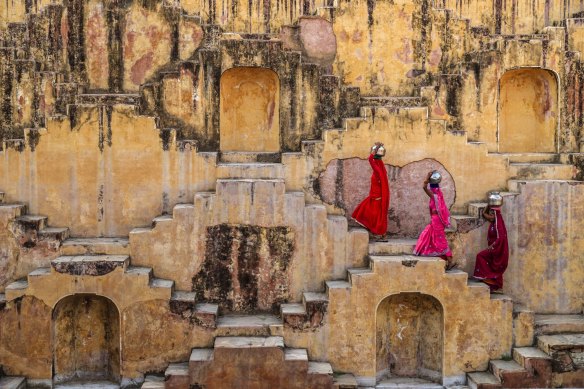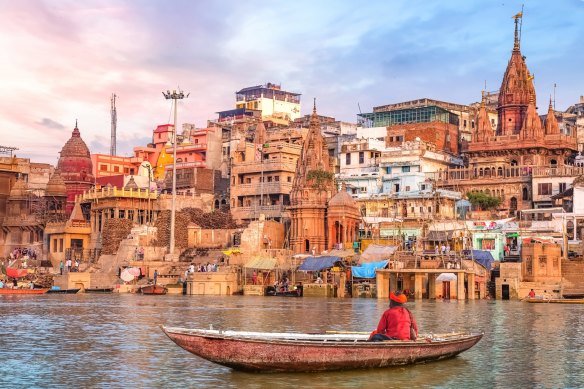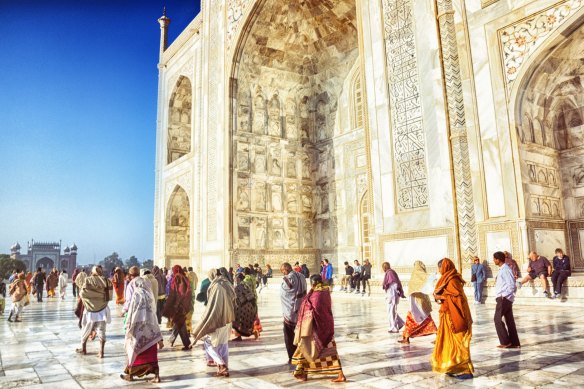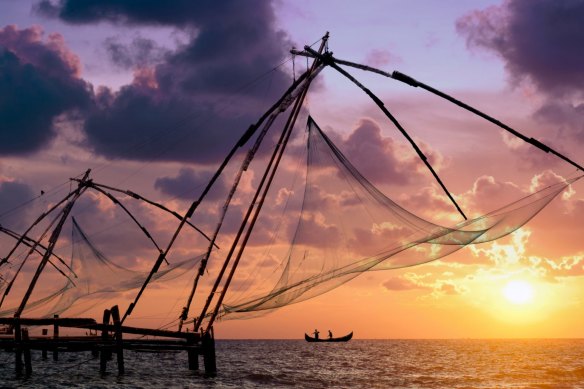This was published 1 year ago
Incredible India: An essential guide for first-time visitors
By Gill Charlton and Anthony Dennis

Women carrying water from a stepwell near Jaipur, Rajasthan.Credit: iStock
India remains one of the world's greatest and most challenging travel experiences. It is also, without question, the most engaging, colourful, chaotic, spiritual and life-affirming country in the world.
Even repeat visitors to India find themselves wide-eyed at the beauty of its cultural treasures, from temple sculptures and palace murals that rival the best of the Italian Renaissance, to the artistic skills of ordinary people in a land where so much is still made by hand.
It's something that the Australian Prime Minister, Anthony Albanese would have encountered during his recent official visit to India where he was feted by his Indian counterpart, Narendra Modi.

The city of Varanasi on the Ganges river.Credit: iStock
His official visit, as well as the much-anticipated tour by the Australian cricket team, put a spotlight on a country with which we share long-standing Commonwealth and sporting ties. Australians of Indian background now represent the largest group of permanent migrants in the country.
The wide use of English, a legacy of the British Raj, also means India is an easy place for first-time visitors to navigate and communicate.
Even so, it is still not a country for the faint-hearted, something of which Albanese himself – as well as present and past Australian cricketers to the subcontinent – would be well aware since he first travelled there as a backpacker.
There is much that is shocking: the poverty, the noise and pollution, the overladen vehicles playing dodgems on the roads – and the complete lack of personal space.
But in a country of 1.4 billion people – and one that is set to overtake China as the world’s most populous country – it’s important to realise that the stares and the questions are often simply a show of polite hospitality to foreigners who have left the protection of their families.
Delhi is the best entry point for a first visit: the orderly tree-shaded streets of monumental New Delhi, designed by Sir Edwin Lutyens in the 1920s, give a soft landing – and a chance to pick up loose cotton clothing on a visit to the Khan Market shopping centre – before heading out into the maelstrom that is modern India.
Attempting to cover too much ground on a first visit is a mistake. A leisurely exploration of a small corner, mixing a few of the major Golden Triangle tourist sites with stays in rural palace hotels and wildlife reserves, will avoid fort-and-temple fatigue and preserve your sense of humour.
Nobody goes anywhere fast on India’s roads. Expect to travel at little more than 50 kilometres an hour, even on inter-city dual-carriageways, for there are constant stops to avoid hitting stray cows and heedless pedestrians.
Trains are slow with shared facilities – even in first class – but the scenery is more interesting by rail than by road (British rail travel expert Mark Smith's excellent seat61.com train travel website will explain everything you need to know).
For couples and groups of friends, the best way to see India is to travel in a chauffeured vehicle. Skilled and experienced drivers are usually knowledgeable and care for their air-conditioned cars beautifully.
For solo travellers, there's a big choice of guided tours, from small-group adventures to classic coach tours of the Golden Triangle.
What follows is an essential guide to all else that you'll need to know for a successful first-time visit to incredible India.
Where to go

Stay overnight in Agra and witness the Taj Mahal early in the morning, before the tourist throngs descend. Credit: iStock
The plains of northern India are dry and dusty, punctuated by extraordinary cities built by Mughal emperors and Rajput princes. Delhi, Agra, Jaipur and Udaipur should be in every first-timer's itinerary, but they are all crowded places that can easily overwhelm.
Intersperse forays into cities with days in the countryside. Do include a couple of nights in Ranthambore National Park where tigers are now easier to see and a stay in one of the magnificent owner-run palaces or fort hotels which will introduce you to the wonders of village India.
Life among the lush green hills and valleys of southern India is altogether slower-paced and less crowded, the landscape peppered with the ruined capitals of long-vanished medieval empires and lively Hindu pilgrimage shrines.
Many visitors head for the well-run state of Kerala. Unfortunately, Keralan beaches are far from clean and most host large fishing communities; they're not places to lay out your towel or swim in the sea.
After a visit to Kochi on the coast and perhaps a night on a backwaters rice barge, head inland to Munnar or Thekkady in the Western Ghats, forested hills where wild elephants roam and tea and spices are grown on estates offering convivial homestays in colonial-era bungalows.
From here, head into Tamil Nadu to explore communities in Madurai, Chennai and Pondicherry before flying across to the Andaman Islands for a few days on a white sand beach.
For sun and sand on mainland India, Goa is the best place to go. Beaches north of Panjim, the capital, are popular for their nightlife, though by day they look rather scruffy and overbuilt.
For cleaner, whiter and quieter sandy strands, head south to Colva and Benaulim: Alila Diwa Goa and the St Regis (formerly the Leela Beach Resort) are well-regarded accommodation options.
When to go and with whom

Kochi on the coast.Credit: iStock
The best time to visit India is from late October (the end of the monsoon season) to mid March with April and May often hot and humid.
Daytime highs of over 40 degrees are regularly recorded on the plains of northern India, though it's a good time to visit the Himalayan foothills and hill stations of Shimla and Darjeeling. High summer, meanwhile, is pleasant in Kashmir and Ladakh.
The monsoon rains start in late May in the south, gradually moving north over the following six weeks, though the timing does vary and it doesn't rain all day every day.
If you like a quiet hotel, avoid the 10 days around the festival of Diwali in November when Indian families holiday en masse and stay up late. The best time to find empty rooms at short notice is during the first two weeks of December.
This being your first trip to India, you may prefer to opt for the security and reassurance of travelling as part of a group tour run by a trusted operator. There are several experienced and respected Australian escorted journeys companies which run regular tours to India.
These include the quality and value-minded Bunnik Tours (bunniktours.com.au) and Wendy Wu Tours (wendywutours.com.au) while for the adventurous, cost-conscious and eco-minded, the Australian-founded global group Intrepid Travel (intrepidtravel.com) will suit.
For travellers seeking a more bespoke, exclusive experience incorporating adventure, comfort and style, consider the small group or independent journeys offered by Classic Safari Company (classicsafaricompany.com.au)
What you’ll need and what to bring
Australians, like most nationalities, require a visa in order to visit India. However, in an effort to promote increased tourism to the country, the Indian government has streamlined the application process for an Indian visa from Australia.
The availability of an eVisa means Australians can apply for an Indian tourist visa online with no need for a trip to the nearest Indian consulate or high commission.
Prospective Australian travellers to India are encouraged to apply through the official government site at indianvisaonline.gov.in
Be ready to provide all of the requisite personal, educational and professional information as well as where you plan to visit in India, your entry and departure points and the countries you’ve visited in the past decade.
A passport-sized photo, with specific size and other requirements, is also needed with the turnaround time for eVisa approval, at a cost of $US80 ($120), being generally between two and three business days. Be aware that there is a four-day minimum period for application before departing Australia.
In terms of what to take, start with a holdall on wheels, which is much easier to stow on trains and tour buses than a large rigid suitcase.
The other must-pack for India is a universal plug for sinks; a torch (preferably a small head torch); slip-off shoes or sandals for temples and entering houses; high-factor sunscreen and a sun hat. Insect repellent with DEET, ear plugs and eyeshades for trains and city hotels; binoculars for birds and murals and a filtered water bottle to help reduce plastic bottle usage.
Staying healthy in India
One Indian tour leader reports that the incidence of illness among his clients has declined since the more widespread use of hand sanitisers. It's worth travelling with an anti-viral hand foam.
Drink at least a litre of safe bottled water a day. If you succumb to Delhi belly stick to a diet of plain rice and yoghurt and drink plenty of fluids for 24 hours.
The Sydney-based Travel Vaccination Clinic (travelvaccinationclinic.com.au) recommends travellers to India ensure all childhood vaccinations are up to date, be vaccinated against hepatitis A and typhoid or ensure that you are current with these shots.
Before you depart, consider getting a COVID-19 booster, the yearly influenza shot and follow strict hygiene procedures when eating and drinking the local food and water as well avoiding mosquito bites whenever possible.
The risk of malaria in India varies with the season in winter with a low risk outside of the states of Orissa and Assam.
This cover story was adapted from the travel section of the Telegraph UK and is reproduced with permission.
MORE MUST-KNOWS FOR A FIRST-TIME VISIT
Brace yourself
Prepare yourself, as a first-timer, to be shocked, appalled and accosted (for food and money) in what is a disturbingly unequal society. Be kind, respectful, caring and generous and fully aware you can't solve all of the problems of such a populous and complex land.
Mind your modesty
While in India do avoid tight-fitting vest tops, above-knee shorts and see-through skirts (Indians regard these as undergarments). Displaying lots of cleavage is a no-no away from the beach.
Use your right hand only
During your India visit, even if you are left-handed, always use your right hand for eating and handing over money or goods. (In explanation, Indians use the left hand for their ablutions so it is considered dirty.)
Be prepared to tip
Many places have a tip box for staff and local guides expect reasonable tips of about $15 for a full day’s work. Tip good drivers about $20 day a day and ask they skip the unrequested shopping stops.
Don't scrimp on your stays
Unless you’re backpacking, don’t economise too much on the quality of your accommodation (find savings elsewhere). Generally, four star-rated hotels and above, with those belonging to respected chains such as Taj, Oberoi and Park, are your best bets.
Greet the day and beat the crowds
Rising early in a crowded India has its rewards. For instance, rather than taking a day trip to the Taj Mahal, stay overnight in Agra, the city where the white marble mausoleum is located, and witness the building as early as dawn, before the tourist throngs descend.
First (aid) things first
Pack a small and portable first aid kit, just in case. Take a pack of doctor-prescribed antibiotics in case of severe illness (the chances are you won't need them but you'll be glad for them if you do) as well as those sachets of electrolytes to keep yourself hydrated.
Ask before your snap
Indians love nothing more than to pose for photographs at famous sights, preferably with an exotic Westerner in the family group. But they do not like being photographed doing menial work in everyday clothing. Always ask beforehand and respect their wishes.
Surviving the pall of fame
Delhi is notorious for smog with the worst months being from November to February, coincidentally the high season for tourists. Being effectively two cities in one (Old Delhi and New Delhi), the capital has much to recommend it but do pack a decent mask.
Take a leaf
Read up before you go and while there. City of Djinns by William Dalrymple skilfully evokes Old Delhi while Holy Cow by Sarah Macdonald is an amusing search for spiritual India. Amitav Ghosh's Sea of Poppies and Vikram Seth's A Suitable Boy are also recommended.
Sign up for the Traveller Deals newsletter
Get exclusive travel deals delivered straight to your inbox. Sign up now.